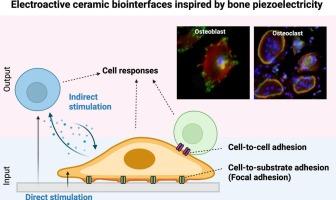基于骨压电原理的电活性陶瓷生物材料走向高级骨工程
IF 6
2区 医学
Q2 MATERIALS SCIENCE, BIOMATERIALS
Materials Science & Engineering C-Materials for Biological Applications
Pub Date : 2025-09-06
DOI:10.1016/j.bioadv.2025.214495
引用次数: 0
摘要
本文综述了受骨压电启发的电活性陶瓷生物界面在高级陶瓷生物材料中的应用。骨在机械载荷下通过胶原原纤维和磷灰石矿物的压电特性产生电势。这些电信号影响成骨细胞的骨传导能力和再生能力。合成陶瓷生物材料可以通过电极化来模拟骨的自然电活动。极化通过增加表面自由能,促进血清蛋白吸附和成骨细胞粘附,同时影响破骨细胞分化,提高生物材料表面的润湿性。这些通过极化的表面修饰可以在不改变表面形态或结晶度的情况下实现,并在生物界面上提供稳定和持久的生物活性。本文详细介绍了极化、蛋白质相互作用和细胞在生物界面上的反应的物理化学机制。了解这些相互作用可以使电活性陶瓷的合理设计有效地引导骨再生。极化陶瓷在骨科、牙科和软组织应用中显示出作为电活性和长寿命生物材料的潜力,这表明再生医学具有广阔的转化范围。本文章由计算机程序翻译,如有差异,请以英文原文为准。

Electroactive ceramic biomaterials on the principle of bone piezoelectricity towards advanced bone engineering
This review concentrates on the electroactive ceramic biointerfaces inspired by bone piezoelectricity for advanced ceramic biomaterials. Bone generates electrical potentials through the piezoelectric properties of collagen fibrils and apatite minerals under mechanical loading. These electrical signals influence osteoconductivity and regenerative capacity by osteogenic cells. Synthetic ceramic biomaterials can be electrically polarized to mimic bone's natural electroactivity. Polarization improves surface wettability of biomaterial surfaces by increasing surface free energy, promoting serum protein adsorption and osteoblast adhesion while also influencing osteoclast differentiation. These surface modifications by polarization can be achieved without changing surface morphology or crystallinity and offer stable and long-lasting bioactivity at biointerface. This review details the physicochemical mechanisms underlying polarization, protein interaction, and cellular responses at biointerface. Understanding these interactions enables the rational design of electroactive ceramics that effectively guide bone regeneration. Polarized ceramics demonstrate potential as electroactive and long lifetime biomaterials in orthopedic, dental, and soft-tissue applications, suggesting a broad translational scope for regenerative medicine.
求助全文
通过发布文献求助,成功后即可免费获取论文全文。
去求助
来源期刊
CiteScore
17.80
自引率
0.00%
发文量
501
审稿时长
27 days
期刊介绍:
Biomaterials Advances, previously known as Materials Science and Engineering: C-Materials for Biological Applications (P-ISSN: 0928-4931, E-ISSN: 1873-0191). Includes topics at the interface of the biomedical sciences and materials engineering. These topics include:
• Bioinspired and biomimetic materials for medical applications
• Materials of biological origin for medical applications
• Materials for "active" medical applications
• Self-assembling and self-healing materials for medical applications
• "Smart" (i.e., stimulus-response) materials for medical applications
• Ceramic, metallic, polymeric, and composite materials for medical applications
• Materials for in vivo sensing
• Materials for in vivo imaging
• Materials for delivery of pharmacologic agents and vaccines
• Novel approaches for characterizing and modeling materials for medical applications
Manuscripts on biological topics without a materials science component, or manuscripts on materials science without biological applications, will not be considered for publication in Materials Science and Engineering C. New submissions are first assessed for language, scope and originality (plagiarism check) and can be desk rejected before review if they need English language improvements, are out of scope or present excessive duplication with published sources.
Biomaterials Advances sits within Elsevier''s biomaterials science portfolio alongside Biomaterials, Materials Today Bio and Biomaterials and Biosystems. As part of the broader Materials Today family, Biomaterials Advances offers authors rigorous peer review, rapid decisions, and high visibility. We look forward to receiving your submissions!

 求助内容:
求助内容: 应助结果提醒方式:
应助结果提醒方式:


